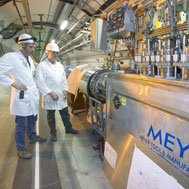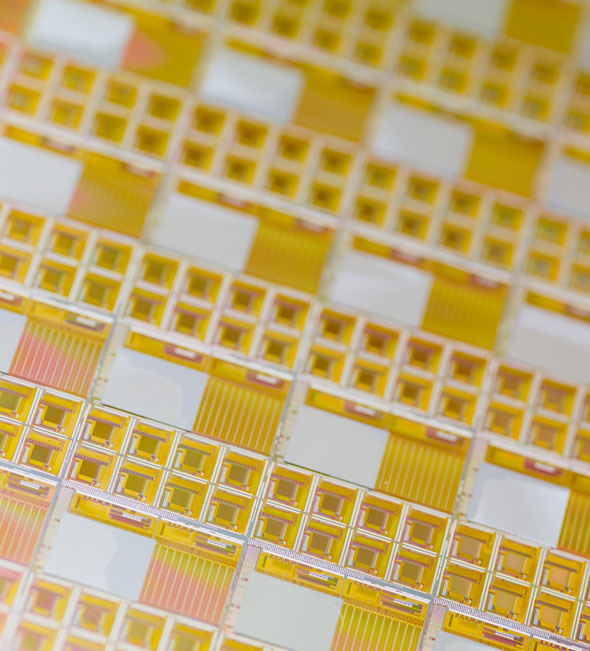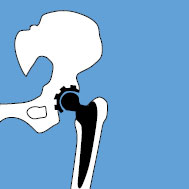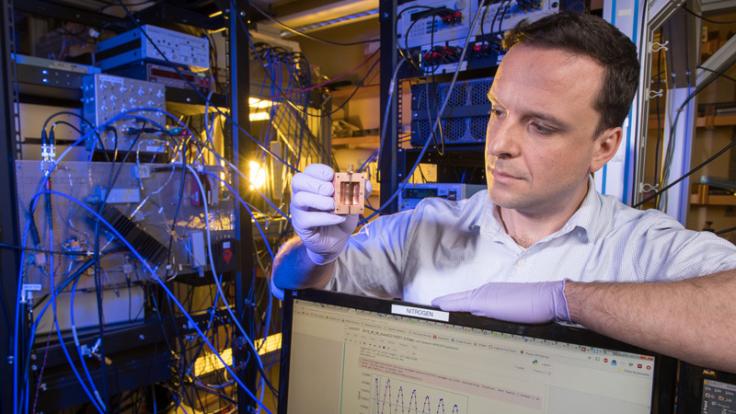Particle physics benefits: Adding it up
Stories abound about how particle physics benefits education, the economy, and society as a whole. Quantifying those benefits would help particle physics better demonstrate its value to the country.
By Elizabeth Clements
|
||
| Photos: Reidar Hahn, Fermilab |
||
As a lead machinist at Argonne National Laboratory, Frank Meyer recognized the need for industry to supply complex equipment for scientific research. So in 1966 he started Meyer Tool & Manufacturing on a part-time basis in his garage. Three years later, he left Argonne to expand his machine shop into a full-time manufacturing facility.
Around the same time, Fermilab, then called the National Accelerator Laboratory, began construction. The fledgling Meyer Tool became the labs key supplier of cryogenic equipment needed to cool the accelerators superconducting magnets.
Today Meyer Tools list of customers includes CERN in Geneva, Switzerland; Lawrence Livermore National Laboratory in California; the National Synchrotron Radiation Research Center in Taiwan; and the Canadian Light Source in Saskatoon, Canada.
 |
| Meyer Tool & Manufacturing made key components for the cooling system in the Large Hadron Collider at CERN. |
|
Photo: Fred Ullrich, Fermilab |
Particle physics has many episodes like this. They are real and sometimes very powerful stories. But in a time of severe fiscal challenges, individual stories are not enough.
What does the US lose if we trade away elementary particle physics? asked Mike Holland of the US Office of Management and Budget at Fermilabs Users Meeting in June. My guess is that the nation would be less competitive and innovative without you, but I dont have anything other than a few anecdotes to make that case.
The Particle Physics Project Prioritization Panel (P5) believes that an objective and rigorous study of the benefits of particle physics on the nations economy could help make the case. Economic impact studies quantify the amount of new income that a facility or service adds to the economy. In a report published in May 2008, the panel stated:
At this time there exist few quantitative analyses of the economic benefits of particle physics applications. A systematic professional study would have value for assessing and predicting the impact of particle physics technology applications on the nations economy.
As envisioned by the P5 group, the proposed study would not focus on the local effects of just one laboratory or institution. Rather, it would cover the broad impacts of the entire field of particle physics across the United States.
The ripple effect
Some economic impacts are easy to quantify, such as dollars spent on payrolls and equipment. Then there are the non-fiscal impacts that add social value, such as training teachers and maintaining open space.
The waves of that pebble going out into the water must be huge, says Dave Brummel, mayor of Warrenville, a town of 14,000 just to the east of Fermilab.
Fermilab, for example, employs about 2000 people with a total payroll of $148.7 million. Ninety percent of the labs employees live in the local area surrounding Batavia, a suburb 40 miles west of Chicago, and pay an estimated $4 million annually in Illinois income tax. On average, the lab spends about $115 million each year in procurementspurchases of everything from high-tech equipment to paper clips. A significant percentage of that total goes to small businesses in Illinois, such as Meyer Tool and Manufacturing.
Projects can range from a few thousand dollars to large ones for hundreds of thousands to millions, says Ed Bonnema, vice president of operations at Meyer Tool. Depending on the year, national laboratory work can vary from 50 to 80 percent of our work.
While the numbers are easy to count, Bonnema believes they are small compared to the indirect effects that should be appraised. A direct line of descent between the basic research done at particle physics labs and things like the World Wide Web, MRI machines, cancer therapy, and superconductors can be made, he says. Thats the stronger case of economic impact that should be described.
Brummel also recognizes the ripple effect that particle physics has on society. Warrenville and West Chicago will each soon be home to $200 million proton therapy treatment centers that together will care for 3000 cancer patients each year. The development of this technology, he says, would not be possible without particle physics.
He adds that the most immediate benefits of having a research facility like Fermilab next door are the simplest. I raised two kids biking out at Fermilab, Brummel says. A lot of the benefits, such as the open space, are esoteric. But then there is the prestige of having this kind of place right there.
 |
| The semiconductor industry relies on accelerator technology to implant ions in silicon chips, making them more effective in consumer electronic products, such as computers, cell phones, and MP3 players. |
| Photo: Reidar Hahn, Fermilab |
 |
| Researchers used the Advanced Photon Source at Argonne National Laboratory to develop Kaletra, one of the worlds most-prescribed drugs to fight AIDS. |
|
Photo courtesy of Abbott Laboratories |
Boosting schools and businesses
Fermilabs cutting-edge research has attracted world-class scientists for decades. In the 1970s, when physicist Bob Kephart was a postdoctoral researcher at Stony Brook University in New York, the prestige of working at the nations premier particle physics laboratory drew him to Illinois. After working at Fermilab for two years on an experiment, I had offers from several universities, he says. However, I realized that I could either live at the place where I was doing research, or I could be on planes all the time. So I chose to live here.
Like many staff scientists who came to Fermilab early in their careers, Kephart stayed. He married another Fermilab employee, built a house in nearby Elburn, had two kids who went to local schools and is now one of the directors at the lab.
Not every scientist will relocate to Fermilab, but thousands visit every year to attend meetings and workshops. They stay in local hotels, eat in local restaurants, and shop at local stores. During peak times at the lab, the Comfort Inn in Geneva estimates that 25 percent of its business comes from Fermilab.
Fermilab is one of three or four companies that we consider our base business, says Mary Bonner, general manager of the inn. A facility like Fermilab stays busy all year long. It always drives traffic to us.
As a result of that steady business, the Comfort Inn is able to reinvest money into upgrading the hotel.
For Robin Dombeck, a middle-school science teacher at Northbrook Maple School in the northern suburbs of Chicago, a laboratory like Fermilab adds social values that indirectly benefit the economy.
In 1983, Dombeck participated in a Fermilab pilot program called Beauty and Charm, a professional development course for teachers, which was named for the two types of quarks now usually known as bottom and charm. At the time, she was in her second year of teaching science at a middle school in LaGrange, Illinois. As a result, my little school got affiliated with a world-class institution like Fermilab, she says.
The following year, the program leaders asked Dombeck to come back as a workshop instructor, combining her teaching experience with Fermilabs expertise in particle physics to create a strong, ongoing program.
The idea of teaching middle-school students particle physics was a new concept then, Dombeck says.
Because of Fermilabs professional development courses, teachers like Dombeck learned how to bring hands-on lessons and inquiry-based learning practices into their classrooms. She says, The strategies that I learned at Fermilab enable me to look at a lesson that is less than exciting and make it into something good.
Better teachers improve schools. Good school systems attract people to live in the area. While placing a numerical value on a service like professional development would be tough, and not advisable according to economists, the social benefit is significant.
Laboratories like Fermilab create social values that are being made available to many other organizations. They are hard to trace, but they are very real, says Bill Batte, president of Capital Management Solutions, a financial consulting firm in St. Charles, Illinois.
 |
| Artificial human joints, such as those for the hip, last longer when industry uses particle accelerators to implant ions and harden the metal material. |
|
Illustration: Sandbox Studio |
The need for numbers
On the local level, particle physics laboratories create jobs and support small businesses. As a field, particle physics helped develop cancer therapies, medical diagnostic tools, and the World Wide Web. All of these add value to particle physics, but their benefits have never been properly assessed.
Holland, who reviews the budget for the US particle physics program, told an audience of Fermilab scientists that he hears examples like these every day, but needs better data to make a convincing case for physics. Equip me to make your case, he said. Ideas and tools are your calling cards, but you need robust theory to help explain them. An avalanche of spin-offs is not enough.
A systematic study would go beyond a mere list of examples and demonstrate how the knowledge and highly skilled workforce that particle physics produce percolate through the US economy. It would document the connections between particle physics and the science and technology that other fields of industry use today, and it would quantify how the national economy would suffer if funding for particle physics continued to diminish.
Holland stressed that for such a study to achieve street credibility, particularly on Capitol Hill, the processwhich should be rigorous, expert, and independentis more important than the outcome.
Get professional help, he says. Engage economists, sociologists, science policy scholars, and historians. They will have the tools and credibility to help.
The Office of High Energy Physics in the US Department of Energy has already conferred with economists and supports the idea of conducting an economic impact study.
The innovative ideas and technologies of particle physics have helped transform the way we live, says Dennis Kovar, associate director for the Office of High Energy Physics. A rigorous and honest study is necessary to fully appraise and attribute the contributions of particle physics to the economic impacts associated with these transformations.
 |
| The auto industry uses particle accelerators to treat the material for radial tires, eliminating the use of solvents that pollute the environment. |
|
Photo: Reidar Hahn, Fermilab |
Economic methods
Economists acknowledge that conducting an economic impact study on particle physics will not be simple. But the right tools and an objective approach make it possible.
We find it interesting. You could make an entire academic career out of a study like this one, says George Tolley, a professor of economics at the University of Chicago and president of RCF Economic and Financial Consulting.
Tolley explains that one possible way of approaching the study is to select four or five technologies that have come from particle physics. Economists could analyze specific case studies that represent the benefits of particle physics research to society and illustrate the ongoing innovation process. Tangible products that economists can count, such as ion-implantation devices, make it possible to quantify their impact on the national economy.
Don Jones, vice president at RCF Economic and Financial Consulting, advises that a study should try to identify things that could not have been done without key contributions from particle physics. This kind of study hasnt been done yet in particle physics, but it is the kind of aggregation that economists have the techniques to do, Jones says.
For example, accelerator technology made it possible to create ion implantation devices, which generate ion beams that scientists use to modify semiconductors and harden materials for hip-replacement joints.
Using the case-study method, economists would work closely with scientists and members of industry to determine which products to analyze and just how much of their economic impact can be attributed to particle physics.
Then, to quantify the value that a technology such as ion implantation contributes to the marketplace, economists would subtract the cost of producing it from the total sales reported by US companies.
You know that you are going to get a low estimate because youre not going to capture everything, but this number will be credible, Jones says. That is important because credibility has been an issue for some previous attempts to quantify the impact of scientific development.
In many instances, particle physics cannot claim full credit for creating a new product, but economists can measure the impact the field had in speeding up its development.
For example, if particle physics didnt exist, it is likely that sooner or later someone would have invented the World Wide Web. But because particle physics collaborations needed a way to quickly share large amounts of data, a computer scientist at CERN invented it and physicists pushed it forward.
Particle physics may have accelerated its introduction by 10 years, Jones says. What is the value of having something like the World Wide Web for those 10 years?
 |
| Superconducting wire developed for particle accelerators made it possible to create powerful magnets for medical diagnostic tools such as magnetic resonance imaging, or MRI. |
| Photo: Reidar Hahn, Fermilab |
In 1985, John Kay, a leading economist in Great Britain, and Sir Chris Llewellyn Smith, the former director general of CERN, published a paper that estimated what the economic impact would have been if electricity had been discovered one year earlier. It worked out to 5 percent of the annual income in Britain, or the equivalent of $40 billion at that time. Put another way, the economic benefit of accelerating the development of electricity by just one year exceeded the cost of all fundamental scientific research undertaken in Britain since the time of Newton.
 That is an astounding result, Jones says. That is an astounding result, Jones says. |
Naturally, a single study such as this one should be taken with a grain of salt, as it is just one example and this is a difficult problem to study. But it provides an approach that could be useful.
Making credible assessments
John Crompton, an economist at Texas A&M University, says that economic impact studies are useful policy tools, but unfortunately they are often not used correctly. He considers most of these studies nothing more than political shenanigans: Every now and then you find an honest one.
Crompton warns that certain methods make it very easy to manipulate a study to produce desirable numbers. An economic impact study on particle physics would need to steer clear of the pitfalls that have tarnished other efforts.
Ultimately, the study should illustrate what the national economy would lose if the field no longer existed.
An economic impact has a technical meaning for economistsnew money coming in, Crompton says. Its powerful stuff when done correctly.
Click here to download the pdf version of this article.









